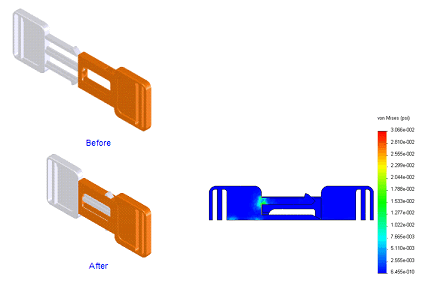Non Linear Analysis
Nature is nonlinear. That means linear analysis can only approximate the real nonlinear behavior of parts and assemblies. Most of the time, such an approximation is acceptable, and linear analysis can provide valuable insight into product characteristics. In many cases, however, linear assumptions differ too much from reality and provide crude or misleading information.
Using the results of linear analysis to decide if a part will fail under its operating loads may lead to overdesign. For example, a bracket design analyzed only with linear analysis requires the designer to stick with a requirement that stress must not exceed the yield. But nonlinear analysis may show that some yielding is used or to choose a less expensive material without compromising structural integrity. An engineer may be concerned about too large a deflection of a flat panel as tested with linear analysis, for another example, and overdesign it to compensate for that deflection without ever knowing that linear analysis exaggerated the deformations, and it was fine as originally designed.


Snapping of buckle is a good example where non linear analysis will give prescribed results. Geometry change together with material response change can be predicted accurately using non linear testing. A linear test will not be able to predict overall behavior accounting for shape and load variation. Some examples where non linear testing will be crucial.
Diaphragm spring : The non linear spring characteristic requires a nonlinear geometry analysis to account for membrane effects.
Pulley : A stamped steel pulley may buckle under belt load before it develops excessive stresses. Although a linear buckling analysis may be enough to determine buckline load, nonlinear analysis is required to study postbuckling behavior.
Allen wrench: Contact between wrench and socket screw necessitates contact stress analysis.
Historically, engineers were reluctant to use nonlinear analysis, because of its complex problem formulation and long solution time. That's changing now, as nonlinear FEA software interfaces with CAD and has become much easier to use. In addition, improved solution algorithms and powerful desktop computers have shortened solution times. A decade ago, engineers recognized FEA as a valuable design tool. Now they are starting to realize benefits and greater understanding that nonlinear FEA brings to the design process.
Rajat Trehan
Product Manager – Design Validation
Computer Aided Technology Inc.

 Blog
Blog